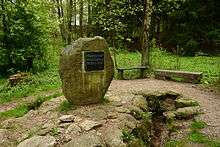Lusatian Neisse
| Lusatian Neisse | |
| River | |
 Nysa near Skerbersdorf, Krauschwitz municipality | |
| Countries | Czech Republic, Poland, Germany |
|---|---|
| Source | Jizera Mountains |
| - location | Nová Ves nad Nisou, Liberec Region, Czech Republic |
| - elevation | 655 m (2,149 ft) |
| - coordinates | 50°43′47″N 15°13′44″E / 50.72972°N 15.22889°E |
| Mouth | Oder |
| - location | Neißemünde, Brandenburg, Germany |
| - elevation | 32 m (105 ft) |
| - coordinates | 52°4′11″N 14°45′20″E / 52.06972°N 14.75556°ECoordinates: 52°4′11″N 14°45′20″E / 52.06972°N 14.75556°E |
| Length | 252 km (157 mi) |
| Basin | 4,297 km2 (1,659 sq mi) |
| Discharge | |
| - average | 30 m3/s (1,059 cu ft/s) |
 Oder and Neisse rivers
| |

The Lusatian Neisse[1][2][3] (Czech: Lužická Nisa; German: Lausitzer Neiße; Polish: Nysa Łużycka; Upper Sorbian: Łužiska Nysa; Lower Sorbian: Łužyska Nysa) is a 252-kilometre (157 mi) long river in Central Europe.[4][5] It rises in the Jizera Mountains near Nová Ves nad Nisou, Czech Republic, reaching the tripoint with Poland and Germany at Zittau after 54 kilometres (34 mi), and later forming the Polish-German border for a length of 198 kilometres (123 mi). The Lusatian Neisse is a left-bank tributary of the river Oder, into which it flows between Neißemünde-Ratzdorf and Kosarzyn north of the towns of Guben and Gubin.
According to the 1945 Potsdam Agreement in the aftermath of World War II, the river became part of the Polish western border with Germany (the Oder-Neisse line). Being the longest and most notable of the three rivers named Neisse (Neiße) (German) or Nysa (Polish) (the two other rivers being Nysa Kłodzka (Glatzer Neisse) and Nysa Szalona (Wütende Neiße or Jauersche Neiße)), it is simply referred to as the Nysa or Neisse. An older Polish variant, no longer used, was Nissa.[6]
Name
Since the river runs through the historic region of Lusatia, the adjective before the name of the river Neisse is used whenever differentiating this border river from the Nysa Kłodzka (Glatzer Neisse) and the small Nysa Szalona (Wütende Neisse or Jauersche Neisse), both in Poland.
Cities
At Bad Muskau the Neisse flows through Muskau Park, a UNESCO World Heritage Site. Cities and towns on the river from source to mouth include:
- Jablonec nad Nisou, Czech Republic
- Vratislavice, Czech Republic
- Liberec, Czech Republic
- Chrastava, Czech Republic
- Hrádek nad Nisou, Czech Republic
- Zittau, Germany
- Bogatynia, Poland
- Görlitz, Germany; Zgorzelec, Poland
- Pieńsk, Poland
- Bad Muskau, Germany; Łęknica, Poland
- Forst (Lausitz), Germany
- Guben, Germany; Gubin, Poland
Tributaries
Right bank:
Left bank:
See also
References
- ↑ Tockner, Klement; Uehlinger, Urs and Robinson Christopher T. (2009). Rivers of Europe, Academic Press, London, Burlington and San Diego. ISBN 978-0-12-369449-2.
- ↑ Fritsch-Bournazel, Renata (1992). Europe and German Unification, Berg, Oxford and Providence, RI, p. 106. ISBN 0 85496 979 9
- ↑ McKenna, Amy (2014). Estonia, Latvia, Lithuania, and Poland, Britannica Guide to Countries of the EU, New York, p. 193. ISBN 978-1-61530-991-7.
- ↑ Neisse River at www.britannica.com. Retrieved 4 Feb 2011.
- ↑ Transnational Pilot River Basin at http://eagri.cz/public. Retrieved 4 Feb 2011.
- ↑ Dekret z dnia 26 października 1945 r. o ustanowieniu "Medalu za Odrę, Nissę, Bałtyk" (Dz. U. z 1945 r. Nr 50, poz. 285)
External links
| Wikimedia Commons has media related to Lusatian Neisse. |
- Bibliography on Water Resources and International Law Peace Palace Library
- Closed Germany-Poland bridges
| ||||||||||||||||||||
|
